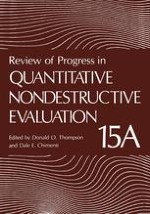1996 | OriginalPaper | Buchkapitel
Advances in the Theory and Practice of Squid NDE
verfasst von : A. Cochran, G. B. Donaldson, C. Carr, D. McA. McKirdy, M. E. Walker, U. Klein, J. Kuznik, A. McNab
Erschienen in: Review of Progress in Quantitative Nondestructive Evaluation
Verlag: Springer US
Enthalten in: Professional Book Archive
Aktivieren Sie unsere intelligente Suche, um passende Fachinhalte oder Patente zu finden.
Wählen Sie Textabschnitte aus um mit Künstlicher Intelligenz passenden Patente zu finden. powered by
Markieren Sie Textabschnitte, um KI-gestützt weitere passende Inhalte zu finden. powered by
The superconducting quantum interference device (SQUID) holds great promise for electromagnetic nondestructive evaluation (NDE) because it offers high sensitivity -permitting high lift-offs or very small excitation signals — and maintains this sensitivity from DC to high frequencies [1]. In eddy current NDE, this allows an induction coil to comprise only a few turns, or even a single filament, without a high permeability core, and makes forward modeling and inverse processing easier, since the induction source is well defined and the SQUID itself closely approximates an ideal sensor. However, the SQUID also has practical drawbacks, including the need for cryogenic temperatures and for differential configurations for measurements in environmental fields. Until very recently, almost all SQUID NDE systems were based on low temperature superconductors (LTSs), but the first measurements with high temperature superconductor (HTS) SQUIDs are now being reported [2–4].
